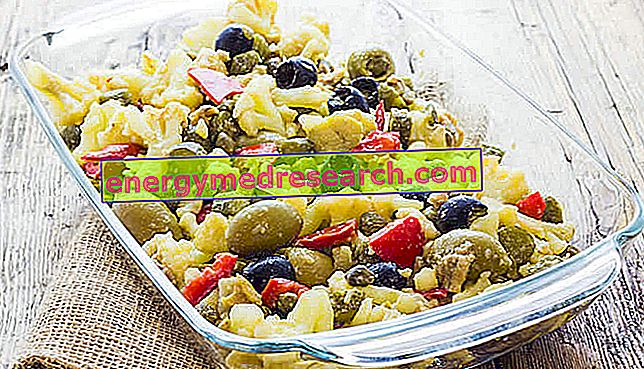What's this ?
The reinforcement salad is an Italian recipe originally from the city of Naples. It is used as a side dish in winter and especially Christmas.
The key ingredient is boiled or steam-cooked cauliflower, usually accompanied by olives, other vegetables, anchovies, spices, oil and vinegar; it is not uncommon for reinforcing salads to be added to the previous meals, such as tuna, boiled eggs, pickled or pickled vegetables, etc.

A typical aspect of the reinforcing salad is the continuous refilling of the ingredients which, in some cases, extends the shelf life until the first days of January.
The reinforcing salad is a valid substitute for all pickles and pickles, as it saves fermentation and maturation time. On the other hand, it does not boast the same nutritional characteristics acquired thanks to bacterial metabolism, much less the same flavor as long-seasoned products. A positive aspect is the lower acidity, an easily adjustable characteristic with the discretionary quantity of wine vinegar.
In the reinforcing salad, the vegetables are partially cooked in boiling water or steam; the ideal time represents a compromise between whitening (which would leave them raw inside) and boiling (which would cook them completely). This feature means that:
- to the touch, they remain very crunchy
- peppers and carrots become sweeter
- fennel loses its hints of anise
- the onions reduce acidity and "aromatic power".
The ingredients of the reinforcement salad are quite variable and subject to interpretation. The same applies to the degree of flavor, acidity and possible spiciness.
Nutritional Features
The reinforcing salad is a very rich side dish, with a significant energy contribution but not excessive.
The calories of the reinforcing salad are mainly supplied by the lipids of extra virgin olive oil, which is why monounsaturated unsaturated fatty acids prevail. Cholesterol is absent, while fibers are abundant.
| Nutritional composition for 100g | |||||||||||||||||||||||||||||||||||||||||||||||||||||||||||||||||||||||||||||||||||||||||||||||
 | |||||||||||||||||||||||||||||||||||||||||||||||||||||||||||||||||||||||||||||||||||||||||||||||
Nutritional values (per 100 g of edible portion) | |||||||||||||||||||||||||||||||||||||||||||||||||||||||||||||||||||||||||||||||||||||||||||||||
| |||||||||||||||||||||||||||||||||||||||||||||||||||||||||||||||||||||||||||||||||||||||||||||||
In the reinforcing salad, carbohydrates and proteins are present in similar quantities; the carbohydrates, slightly more abundant, play however an energy role of little significance and are mainly simple (fructose). The proteins, contained in both vegetables and anchovies, are deficient and (overall) have a rather poor biological value.
From the saline point of view, the reinforcing salad is very rich in potassium, while the sodium levels depend mainly on the discretionary addition of cooking salt.
As far as vitamins are concerned, the reinforcing salad is rather rich in retinol equivalents (pro vit A), ascorbic acid (vit C) and tocopherols (vit E).
This recipe is suitable for most diets, even if the presence of anchovies precludes its use for vegan and vegetarian diets. On the other hand, it contains neither gluten nor lactose.
The reinforcing salad shows no nutritional contraindication for healthy subjects. Keep in mind that, being rich in potassium, it cannot be consumed freely by those suffering from kidney failure; moreover, the significant presence of vegetables of the genus Brassica (cabbage) rich in vit K (anti-hemorrhagic vit), negatively interferes with a possible anticoagulant therapy based on Coumadin.
The chemical composition of fatty acids and the abundance of fibers make the reinforcement salad pertinent also in the nutritional treatment of metabolic pathologies (hyperglycemia and type 2 diabetes mellitus, hypercholesterolemia, hypertriglyceridemia); however, potassium is always very useful in food therapy controlling primary arterial hypertension. In the latter case, it is also necessary to avoid adding table salt to flavor the food.
The portion of reinforcement salad is free for healthy subjects (paying attention to the seasoning) but, in case of overweight, it should be around 150-250g (115 -195kcal).
recipe
The reinforcement salad does not have a very complex recipe.
The ingredients and the basic steps are summarized below, but as anticipated, we remember that the formula can be varied and interpreted in a completely subjective way.
Ingredients
- 1 head of cauliflower cut into tufts,
- 1/2 cut black cabbage,
- 3 red peppers cut into strips,
- 2 peeled and sliced carrots,
- 3 ribs of celery cut into rounds,
- 16 onions,
- 1 fennel cut into thin slices,
- 1 tablespoon of rinsed and recovered salted capers
- 8 anchovies / anchovies in salt well rinsed (or marinated),
- 18 pitted Gaeta olives,
- 18 pitted green olives,
- 5 tablespoons of chopped parsley,
- 250g of salt,
- ½ glass of extra virgin olive oil,
- 700ml of white wine vinegar,
- 2 tablespoons of red wine vinegar,
- 1 tablespoon of fennel seeds,
- 4 whole garlic cloves,
- 6 liters of water to cook and water with ice QB to cool.
NB. They are optional: shallots, dill, oregano and raw hot peppers (habanero or jalapenos).
Method
- Wash, clean and cut the ingredients; to recover the capers.
- Bring 6 liters of water to the boil and add 2 tablespoons of salt.
- Dip the tops of cauliflower and the leaves of black cabbage and cook 9-10 '.
- Keeping the cooking water, remove the cauliflower and the black cabbage to cool them in a bowl with ice water.
- Remove two liters of cooking water and add 3 glasses of white wine vinegar, a little salt, fennel seeds and garlic; then bring to a boil.
- Plunge the carrots, pepper, celery, fennel, onions and cook 10-12 minutes, or until they become tender.
- Remove the vegetables and cool them in the bowl with ice water.
- In a large bowl, combine: cauliflower, onions, pepper, carrots, celery, fennel, garlic, anchovies, olives, capers, red vinegar, oil, parsley, salt and pepper.
- Stir and arrange on a serving plate decorating with olives and anchovies, then serve.



